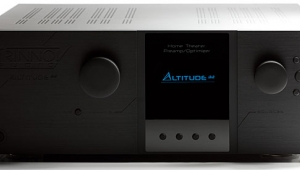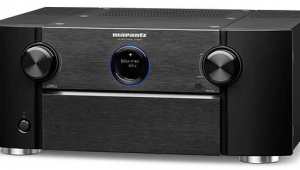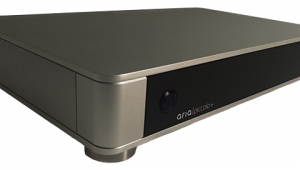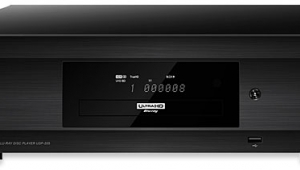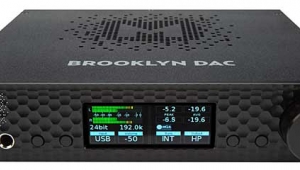| Columns Retired Columns & Blogs |
Music In The Round #5
As noted in the March installment of "Music in the Round," there are so many new multichannel hardware goodies to talk about that we need this bonus appearance of the column just to keep up. Nor do I expect the rush of gear to stop—I've just returned from CES in Las Vegas, where there was lots of new multichannel hardware and software that I will report on in June, including a luscious all-tube analog multichannel preamp. This month I report on a universal disc player, a comparison of Sony's top-of-the-line SCD-XA9000ES multichannel SACD player with its respected predecessor, and a multichannel preamp that's almost too good a deal.
Marantz DV8400 universal player
Unlike the behemoth players from Sony and Meridian, the Marantz DV8400 ($1695) is relatively small, but at more than 17 lbs it's hardly lightweight. Its size and simplicity of operation make it seem more similar to the Linn Unidisk 1.1 that I reviewed last December. The front-panel controls are large, round, and few in number: the basic transport controls and a power/standby switch. The disc tray is central, above a bright, discreet display panel and its associated dimmer button and indicator.

The display indicates tracks and timing, format type, sample rate (for high-rate DVDs), functional mode (including Down Mix), and the number of channels in operation. The latter, however, tells you only what the DV8400 is set up for, not whether there is actually a signal on any given channel. Thus, the indicator shows all 5.1 channels going even when playing Pentatone RQR discs, which have only four channels. Also, despite its clarity and brightness, the DV8400's display is not large enough for me to see from my listening seat. Fortunately, most of the DV8400's complexities are accessible via an onscreen display (OSD) navigable with the excellent remote control. Marantz uses different sizes and shapes for the buttons and groups them logically so that they're easy to locate when you have a particular command in mind.
The rear panel is also deceptively simple for such a capable machine. Video outs include component, DVI, composite, and S-video. Analog audio outs include eight jacks for six channels, with redundant front L/R jacks. Digital outputs include S/PDIF coax and TosLink; depending on the setting and the disc, these will output stereo signals at up to 96kHz from DVD-Audio discs (if allowed by the content provider). Various control interfaces and an EIA power terminal complete the array.
Did I mention OSD? Well, it's a fact of life with this machine, at least for setup and for many DVD-As. Of course, you can manage without the OSD after confirming your setup choices, but while I acknowledge the "tray or play" system, it's easier and more reassuring to access the menus on the screen. The readouts on the front-panel display are okay but not a complete replacement. There are many menus and submenus to access, depending on your audio/video needs, but basically, you must tell the DV8400 how many channels you listen through, whether you want direct (unprocessed) output from the analog and digital jacks, and how big and how far away the speakers are. Marantz provides a chart in the user's manual that neatly lays out what you get from each output in this matrix of options. What I found curious was the manual's emphasis on DVD settings, despite their official naming of the unit as a "Super Audio CD/DVD Player." Often, it was unclear whether a given setting applied to media other than DVD without attending to color-coding on the OSD.
The DV8400 had no trouble reading and playing any disc I popped in. It took a few seconds to determine a disc's format, but no longer than did a Sony SCD-XA777ES, which handles only CDs and SACDs. The time taken seemed to be the same for all formats, and independent of the format of the preceding disc. With the default set for multichannel, I couldn't switch to two-channel operation (or vice versa) without entering the OSD, which can be done on the fly.
The sound with all formats was just fine. Playing "Red Book" CDs, the DV8400 was a capable performer offering balanced sound, extended frequency range, and good soundstage imaging and depth. If any criticism could be raised of the DV8400's CD performance vs its price, it might be that the Marantz lacked a little in dynamics, sounding a bit laid-back. When I fed its digital output to a topnotch DAC such as the Orpheus, I could hear things jump alive—but without such a direct comparison, it was more than good on its own, and plenty so for the money. In fact, it was usually easier to listen to than the Sony XA777ES, which offers a more warts-and-all revelation.
The DV8400's SACD performance was surprisingly similar to its CD sound: clear, detailed, and spacious, but again somewhat laid-back. This served it well, as it contributed to the overall spaciousness of the sound and seemed less affected by room acoustics than players offering a closer perspective. Turning to the latest delight from Mari Kodama—the second piano concertos of Chopin and Loewe, with Kent Nagano and the Russian National Orchestra (Pentatone PTC 5186 026)—I could hear all the glitter and detail, along with the sound of the empty hall. (Am I the only one who hears the thematic similarity between the opening of Chopin's first movement and that of Loewe's second movement? What a great pairing!) But when I played the disc in the Sony XA777ES, during the last movement of the Loewe I was distracted by all the creaks from the chairs and floorboards. Sure, I could hear them with the Marantz as well, but I could more easily ignore it and enjoy the music. Which is more accurate? Dunno, but I could find other examples that favored the Sony's bolder presentation.
The playback of DVD-Audio was where the DV8400 really shone. Since the departure of the Meridian Reference player from my multichannel system, I've been using mostly the old Technics DVD-A10 for DVD-V and DVD-A. I missed the Meridian's ability to throw a wide soundstage not anchored to the speakers. The Marantz could bring it back, as demonstrated in spades by the exciting ARTS-Music DVD-As—my remarks above about the Wagner disc were based primarily on the Marantz's contribution.
Equally delectable although less splashy is Handel's Messiah, with Diego Fasolis conducting soprano Lynne Dawson, mezzo-soprano Guillemette Laurens, tenor Charles Daniels, bass Antonio Abete, and I Barrochisti and the Swiss Radio Chorus (ARTS 45007-6). Taped in 5.1 channels at 24-bits/96kHz during a live performance and presented on a single disc without additional EQ and minimal processing, this release finally gives us a multichannel Messiah of stature. (The packaging says there's a two-channel hi-rez track as well, but I couldn't find it.) All performers are quite excellent, although my ear finds it hard to adapt to Abete's accent. The sound is open and airy in the best sense, and throughout the entire performance there is a consistent transparency and stability in which every voice sounds true. The Marantz was absolutely outstanding in delivering all this. The Linn did no better, and the venerable Technics DVD-A10 failed to re-create the sense of place, with voices, particularly of the chorus, popping here and there.
Over the months I had the Marantz DV8400, it never failed to do well. Other players may at times have been a little more revealing or engrossing, but they were not universal, and/or cost much more than $1695. As much as I like the Linn Unidisk 1.1, I think I like the much less expensive Marantz even more—it seems to share much of Linn's functional style at a price that won't make your eyes cross. The Marantz may not be the Linn's equal in any given function (except in its remote, which is superior to the Linn's), but it comes pretty close in sound.
Sony vs Sony
True to his word, after he reviewed the new Sony SCD-XA9000ES multichannel SACD player last December, John Atkinson sent it to me for a head-to-head comparison with its predecessor, the SCD-XA777ES. Their control layouts are almost identical, but the XA777ES had a flat black front panel while the XA9000ES has a beveled silver faceplate, which makes the latter seem much bulkier than it is. Still, the actual control differences are few. The new unit replaces the Stereo/MCH switch with switches for iLink and SACD/CD, and the placement of the buttons on the beveled surface makes them marginally easier to use.
S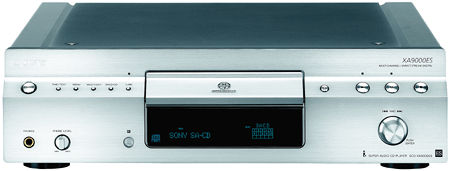
ave for the new iLink jack, the XA9000E's rear panel is also almost identical to the XA777ES's, but user-interface differences lurk just below the surface. First, because the XA9000ES has no LEDs to indicate whether the player is in stereo or multichannel mode or playing an SACD or a CD, this information has been transferred to the model's LCD display, where the relevant labels are illuminated in characters that were too small to see from my listening position. (The LEDs on the XA777ES are distinct from the same position.) Second, the XA9000ES's two-channel and multichannel output jacks are always active with all media, as long as the iLink is not in operation. So you can use the two-channel jacks for stereo sources, taking advantage of the triple paralleled (Tri-Powered D/A) DACs, and as your front L/R channels with multichannel sources. On the XA777ES, they were not simultaneously active and required eight analog interconnects (and two sets of preamplifier-processor inputs) for stereo and multichannel operations. Third—and this is of significance only for multichannel listening—the XA9000ES adds speaker-distance compensation, which the XA777ES lacked.
- Log in or register to post comments


